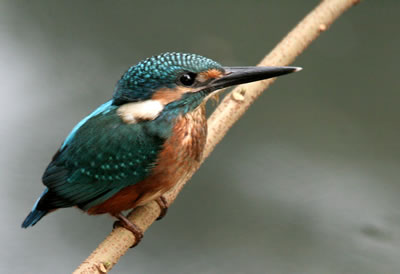Kingfishers

Facts about creatures
- Home
- Animal Classification
- Animal Habitats
- Amphibians
- Arthropods
- Bats
- Birds
- Carnivorans
- Cetaceans
- Chordates
- Crustaceans
- Dinosaurs
- Diprotodonts
- Elephants
- Fish
- Golden Mole
- Insects
- Lagomorphs
- Mammals
- Mammal Teeth
- Marsupial Mole
- Metamorphosis
- Mollusks
- Primates
- Reptiles
- Rodents
- Ruminants
- Soricomorphans
- Tenrec
- Tetrapods
- Vertebrates
Kingfishers
Kingfishers are a group of small, brightly colored birds, many of which hunt for fish by diving into water.
They are found all over the world, in tropical and temperate regions.
While kingfishers often live near lakes and rivers, many species live in forests.
Many forest species are threatened because of habitat loss.
Kingfishers vary widely in size, from about 4 to about 17 inches tall.

A kingfisher has a big head with a long, sharp, pointed bill that is useful for catching fish. It also has short legs and a stubby tail.
Many kingfishers have crests on their heads that they can raise and lower.
Kingfishers usually hunt by waiting on perches near water and then suddenly diving down into the water to catch their prey.
Their vision is extremely acute. They have stereoscopic (binocular) vision and can judge depth in the air and in the water.
A kingfisher’s eyes have nictitating membranes, transparent membranes that are sometimes called third eyelids. These membranes protect the bird’s eyes when it lands in the water.
In addition to fish, kingfishers also eat insects, spiders, worms, crustaceans, frogs and snakes
Kingfishers nest in holes. They often dig tunnels in the banks of rivers, lakes and streams. Their nests are at the ends of these tunnels.
Forest species build nests in tree holes or in termite nests (termitariums) in trees.
Common Kingfisher
The common kingfisher (Alcedo atthis) lives in Europe, Asia and North Africa.
It is also known as the Eurasian Kingfisher or the River Kingfisher.
Like many kingfishers, the common kingfisher dives into water to catch fish as well as amphibians and water-dwelling invertebrates.
Common kingfishers tend to live near clear water, in which they can see their prey. They perch on branches that hang over the water.
Those that live in places where water freezes in winter will migrate.
Both the male and female common kingfisher work together to build a nest, which lies at the end of a tunnel in a vertical riverbank.
The tunnel is usually about two or three feet long and about 2 ½ inches in diameter.
The kingfisher’s nest, which is a depression at the end of the tunnel, is lined with fish bones and regurgitated pellets (balls of undigested food).
The female lays between 5 and 7 eggs.
Both parents incubate the eggs, which hatch in about three weeks.
The young are altricial – unable to move about on their own when they hatch.
Both parents feed them small fish.
The young birds take turns eating.
As the shadow of the parent falls on the tunnel’s entrance, each of the chicks, which are positioned in a circle, moves over one place.
This way the chick behind the one that was last feed is in position to receive the fish that the parents brought this time.